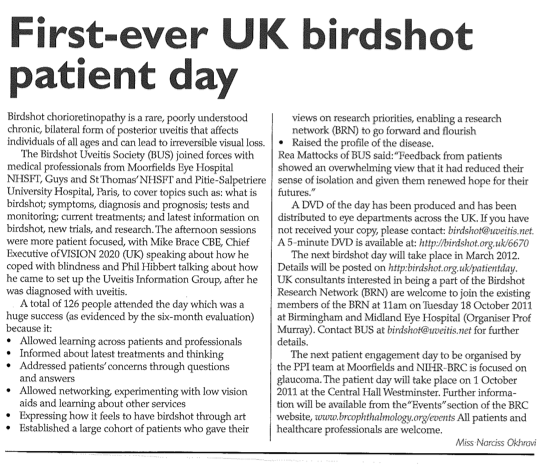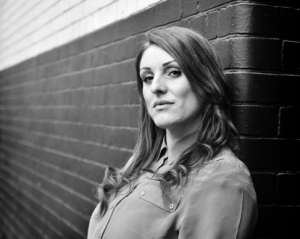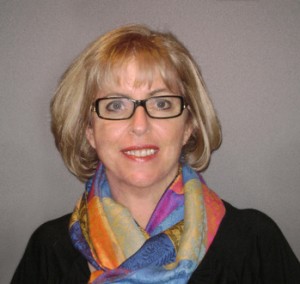We explained that we are trying to set up a Biobank to collect and store samples from each person with Birdshot so that research can be carried out by clinicians and researchers throughout the UK. Most people who attend regional centres could have their samples taken at their regional centre.
For those people who do not attend regional centres, (we think there may be about 40 people), we are hoping to take their samples at the Birdshot Day, if we manage to progress the Biobank in time.
We, therefore, need to accommodate the taking of these samples within the Birdshot Day, without disadvantaging these people and making them miss the talks.
OPTOS will also be there. They are one of our sponsors for the day. They are coming along with their imaging equipment and a technician. We hope that they might be able to image every single birdshot person’s eyes on the day. It is quick, easy and painless takes about 30 seconds an eye, and it is fun. (We know we had it done at the London Euroretina this year). This will give a snap shot of all the eyes there on the day and will be very useful information for our doctors and clinicians.
We agreed that we would have an ‘open’ morning at the Birdshot Day with a variety of activities and keep the talks for the afternoon.
There were a lot of suggestions for the morning and afternoon, and we have tried to incorporate all views from our meeting, as well as all views expressed through feed-back from the previous Birdshot Day. Here is what the timetable looks like following all feed-back.
If any of you have further suggestions for stalls, please let us know. More importantly, if any of you have any contacts to staff these stalls, please, please get in touch with us. We need all the help we can get!
| Time | |||
| 10 am – 1.00 pm (including tea and coffee) | General Activities including networkingTaking samples of boods/DNA, etc for those people who do not attend regional centres Stalls: (Please note that these are all proposals and we need to do some work to see if we can get hold of these people – anybody able to help?) Fund-raising staffed by Sandra Foot to raise money with her arts and crafts – anybody else want a fund-raising stall? BUS staffed by Annie and Rea to offer information and advice Professionals staffed with ophthalmologists and uveitis nurses so that people can ask questions and get adviceExpert patients for advice information and support any of you feel you are expert patients who can advise? Expert friends, families and carers to provide information and advice. Anyone an expert carer/friend/family member? Regional stalls – Where we have already set up regional Birdshot networks (e.g. London) – information on those networks and how to join Information about the National Birdshot Research Network and the Birdshot Biobank How to take your medication – information on how and when to take your various different medications to make them most effective – a pharmacist – who? Low vision aids including specialist glasses Driving with Birdshot information on DVLA requirements and driving options – Lesley F Registering as partially sighted benefits and disadvantages of registering – who? ipads and kindles so that people can see whether using these will help them read books, etc – John H Eye drops Scope Ophthalmics for those people with dry eyes and belpharitis – Rea Nutrition information on diets and nutrition to keep us healthy – who? Anyone able to help with this? Supplements information on supplements and what supplements might help and how to take them with your current medication regimes – Nick and Caroline Cosmetic surgeon who is qualified to advise about whether various procedures can be undertaken while taking our particular medication – who? Anyone able to help? RNIB – information on services offered – Rea AGNSS and SCG The specialist government agencies that decide on what medications people with rare diseases should have available to them – Rea Bates/Alexander and Head massages Lizzie May Chiropractic – Mikael Petersen looking at your posture and what may help Complementary approaches – mindfullness, acupuncture, ayurvedic medicine, etc – who? Vision simulator RCO Bosu Optometrists – invite your optometrist National Voices The Eye Care Trust Olivia’s Vision Vision 2020 (UK) – Mike Brace Audio Books – where can we get these from? Susan Piper’s paintings Plenary Sessions – if we have a couple of small rooms available, there are requests for patients to tell their stories to those who want to hear other people’s stories and for people to talk about self-help |
||
| 1.00 pm – 2.00 pm | Lunch | ||
| 2..00 pm – 2.30 pm | The latest news on Birdshot – latest research, latest medication regimes | Team of specialists involved in National Birdshot Research Network | |
| 2.30 pm – 3.00 pm | Introducing the National Birdshot Research Network and the National Birdshot Biobank | Team of specialists involved in National Birdshot Research Network | |
| 3 pm -3.30 pm | Bones, DEXA scans and keeping your bones healthy
OR A patient Story |
Dr John Armitstead from St Mary’s Paddington We have had lots of patients offering Who? |
|
| 3.30 pm to 4 pm | Tea | ||
| 4 pm to 5 pm | Panel Session – professionals and expert patients answer your questions | Team of specialists involved in National Birdshot Research Network Rea Mattocks and Annie Folkard | |


